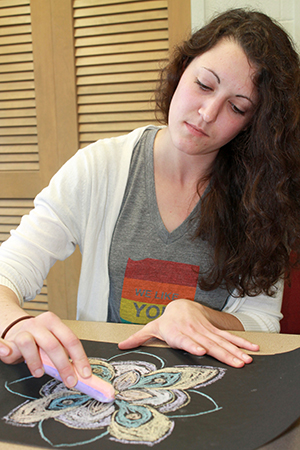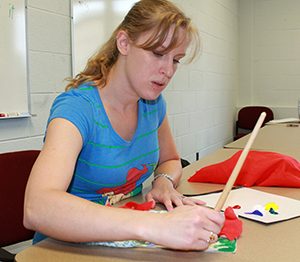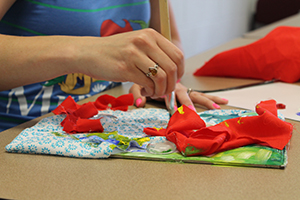By: Sara Palmer
As soldiers they carry into combat radios, guns, supplies and, sometimes, sadly, the bodies of strangers and even friends. As veterans they carry the burden of these memories with them back into their lives. Some of them learn to cope, but many are silently struggling. The emotional turmoil that can result from living with these memories is a condition called post-traumatic stress disorder or PTSD. Studies from the National Center for PTSD show that the disorder prevents more than 30 percent of American veterans from living normal, peaceful civilian lives.
According to the National Center for PTSD, the disorder’s symptoms include nightmares, flashbacks, guilt, shame, fear, anger and hyperarousal (when a person is jittery, hyperaware or has trouble sleeping). Veterans aren’t the only ones who struggle with these debilitating symptoms; more than five million people experience PTSD each year. Often the therapy needed to address the core trauma can be so emotionally painful and draining that many refuse to acknowledge there is even a problem to begin with.
“Research demonstrates dropout rates are high for PTSD-specific treatments,” said Brandi L. Luedtke, Psy.D., HSPP, clinical psychologist at the Roudebush VA Medical Center in Indianapolis, Ind. Since avoidance is one of the symptoms of PTSD, ensuring veterans continue treatment can be challenging. “As a result, there has been increased interest to develop novel and alternative approaches to improve symptoms without requiring direct verbal processing of the trauma.”
Enter art therapy.

“Through the arts we are able to access and use parts of our brains that often would go unused if just involved in talk therapy,” said Quinn Schantz, an Indianapolis resident currently enrolled in the Master of Arts in Art Therapy (MAAT) program at Saint Mary-of-the-Woods College (SMWC) in Terre Haute, Ind. “By becoming involved in art expressions we allow holistic healing to take place as we engage more of our whole being in the healing process.”
Art therapy, as defined by the American Art Therapy Association, is a mental health profession that empowers individuals, working along side a licensed art therapist, to “use art media, the creative process and the resulting artwork to explore their feelings, reconcile emotional conflicts, foster self-awareness, manage behavior and addictions, develop social skills, improve reality orientation, reduce anxiety, and increase self-esteem.” For veterans struggling with PTSD, this form of therapy can be particularly potent.
“Given their nature, traumatic memories are often difficult to express in words alone,” Luedtke said. “Art therapy provides an integrative approach that may serve as a means for exposure to difficult memories and content without direct verbal discussion of the trauma.”
Because many, if not all, of these memories are rooted deeply in emotional distress, art therapy, like all forms of therapy, must be practiced with a licensed professional. Since both making the art and reflecting on the work can trigger heightened emotional responses, a trained art therapist understands best how to support and guide an individual through the process.
“I think a lot of assumptions are made that art therapy is a means of creating something fun or pleasant, when in actuality it can uncover a lot of emotions and memories that many individuals have been attempting to suppress and avoid for many years,” Luedtke explained.
SMWC’s MAAT program prepares clinicians to not only deal with the psychological responses, but also to find the balance between expressing and healing. Because of the program’s hybrid nature, students are located all over the country and can apply the skills they learn right away. “The hybrid residency design allows the student to practice near where they live,” said Jill McNutt, SMWC’s assistant professor of art therapy and operations director of art therapy. “ The cohort model allows camaraderie to form between students in various geographic locations. This adds a diverse dynamic to the learning experience.”
The MAAT program is unique in that it also requires brief residency stints, where a cohort meets on campus several times a year, working together on projects, sharing experiences and enlightening each other with their own thoughts and ideas.

“The part time program allows me to work and be in school, which is much more affordable,” said Amber McCullough Ellis, a second year MAAT student in Evansville, Ind. “The hybrid program gives me some of the benefits of being in a classroom while at residency, but the freedom to complete coursework at my own time when I am home. This helps me to balance my personal responsibilities and my schoolwork.”
Both Schantz and Ellis have seen the benefits of art therapy first hand. Schantz even participated in a Veteran’s Expo, where she conducted personal care and counseling sessions with both male and female veterans. Since trauma is often stored nonverbally, art therapy is a safe and effective way to explore difficult emotions, which is particularly pertinent for veterans, McNutt explained. That reason, among many others, is why SMWC encouraged its students to participate in the expo. The process, like any form of therapy, doesn’t happen overnight; it takes time and commitment to be effective.
“Art therapy is not a system of techniques, it is a philosophical approach where a unique relationship forms between client, artwork, art process and art therapist,” McNutt said. “The art therapist serves as a witness or guide as the client comes into self-understanding and acceptance.”
Art therapists use all kinds of media to facilitate this understanding. In one case, Schantz has seen success just by using stick figures. For other clients, abstract art, molding clay, drawing comic book scenes or painting landscapes have helped them not only deal with the trauma of their past, but find hope in the future.
“It’s a release,” Ellis said. “Art has a way of communicating what words cannot. It also gives our feelings a tangible form, taking what is mental and making it physical. A healing process occurs during the creation of artwork; it can help release what we keep inside: fears, feelings, hopes, dreams, thoughts, anything.”
Because of this release, art therapy is making a significant impact on veterans who are dealing with experiences in combat that haunt them daily. In this abstract format, they are able to look at what they feel, create a physical representation of their emotions or simply redirect their hyperarousal into productivity.
“Art therapy has been shown to alleviate stress and anxiety,” said Luedtke, who conducted an 8-week trial session of art therapy with veterans at Roudebush. They received such favorable feedback from participants that she is currently working on a grant to fund more arts-related therapeutic opportunities at the VA.

“Veterans of our program have been shown to be able to learn to use mindfulness skills to cope with PTSD symptoms and interpersonal stressors,” she said. “Every participant indicated interest in participating in future MB-ART groups if they were available.”
Art therapy is making its way into more mainstream practices and veterans aren’t the only groups who can benefit from this alternative form of therapy. SMWC’s MAAT program prepares its students to use art therapy to help both children and adults cope with a variety of trauma that elicits any number of emotions and behaviors that inhibit them from living healthy, happy and hopeful lives.
“The field offers such diverse opportunities to meet the needs of those we serve,” Schantz said. “Whether it is a veteran experiencing PTSD, an individual with developmental disabilities or a 20-something trying to figure out her life, art therapy has the tools to meet the needs of each person.”
